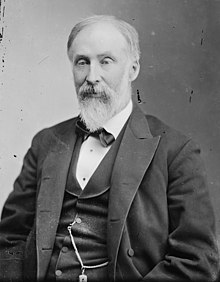Henry L. Pierce
| Henry Lillie Pierce | |
|---|---|
 |
|
| Member of the U.S. House of Representatives from Massachusetts's 3rd district |
|
|
In office December 1, 1873 – March 3, 1877 |
|
| Preceded by | William Whiting |
| Succeeded by | Walbridge A. Field |
| 22nd & 26th Mayor of Boston, Massachusetts | |
|
In office 1873 – 1873 1878 – 1878 |
|
| Preceded by |
William Gaston Frederick O. Prince |
| Succeeded by |
Leonard R. Cutter Frederick O. Prince |
| Member of the Massachusetts House of Representatives | |
|
In office 1860-1862 1866 |
|
| Personal details | |
| Born | August 23, 1825 Stoughton, Massachusetts |
| Died | December 17, 1896 (aged 71) Boston, Massachusetts |
| Resting place | Dorchester Burying Ground |
| Political party | Republican |
Henry Lillie Pierce (August 23, 1825 – December 17, 1896) was a United States Representative from Massachusetts. He was born in Stoughton on August 23, 1825. He pursued classical studies, attended the State normal school at Bridgewater, and engaged in manufacturing. He was elected a member of the Massachusetts House of Representatives, a member of the Boston Board of Aldermen, and served as Mayor of Boston. Pierce was elected as a Republican to the Forty-third Congress to fill the vacancy caused by the death of William Whiting. He was reelected to the Forty-fourth Congress and served from December 1, 1873, to March 3, 1877. He declined to be a candidate for renomination, was again Mayor of Boston in 1878, and died in that city on December 17, 1896. His interment was in Dorchester South Burying Ground on Dorchester Avenue in Dorchester Lower Mills.
In 1896, the City of Boston named the intersection of Dorchester Avenue and Washington and Adams Streets in Dorchester Lower Mills “Pierce Square” in memory of Henry Lillie Pierce. Today, few residents of the area know that this is the official name of the Lower Mills intersection, nor are they familiar with the myriad accomplishments of the man for whom it was named.
Henry Lillie Pierce (1825–1896) was the son of Colonel Jesse Pierce (1788–1856) and Elizabeth Vose Lillie Pierce (1786–1871) of Stoughton, Massachusetts. His father had been an educator at Milton Academy and later served in the Massachusetts House of Representatives. As a gentleman farmer, he maintained a large farm in Stoughton (formerly a part of Dorchester) until he moved, in 1849, to Washington Street in the Lower Mills of Dorchester with his wife and two sons. Edward Lillie Pierce was then attending Brown University, while Henry Lillie Pierce was at Milton Academy and was to later attend the Bridgewater Normal School. In 1849, Henry L. Pierce was hired to work as a clerk at the Baker Chocolate Company. Walter Baker, the owner of the chocolate company and stepbrother of Pierce’s mother, hired him at a salary of three dollars per week. However, as their political views invariably clashed and caused tremendous animosity (Pierce was a vociferous and deeply opinionated Free-Soiler), Pierce left after only a year of politically tinged employment to take up newspaper work in the Midwest. At the request of Sydney Williams, brother-in-law of Baker and managing director of the chocolate mill, Pierce returned to Boston after a year and was appointed manager of the Walter Baker Counting House at 32 South Market Street in Boston (now a part of the Quincy Market retail area). Pierce was obviously a hard worker, for after the deaths of both Walter Baker (in 1852) and Sydney Williams (in 1854), he was permitted to lease the chocolate business from the trustees of the Baker Estate.
...
Wikipedia
